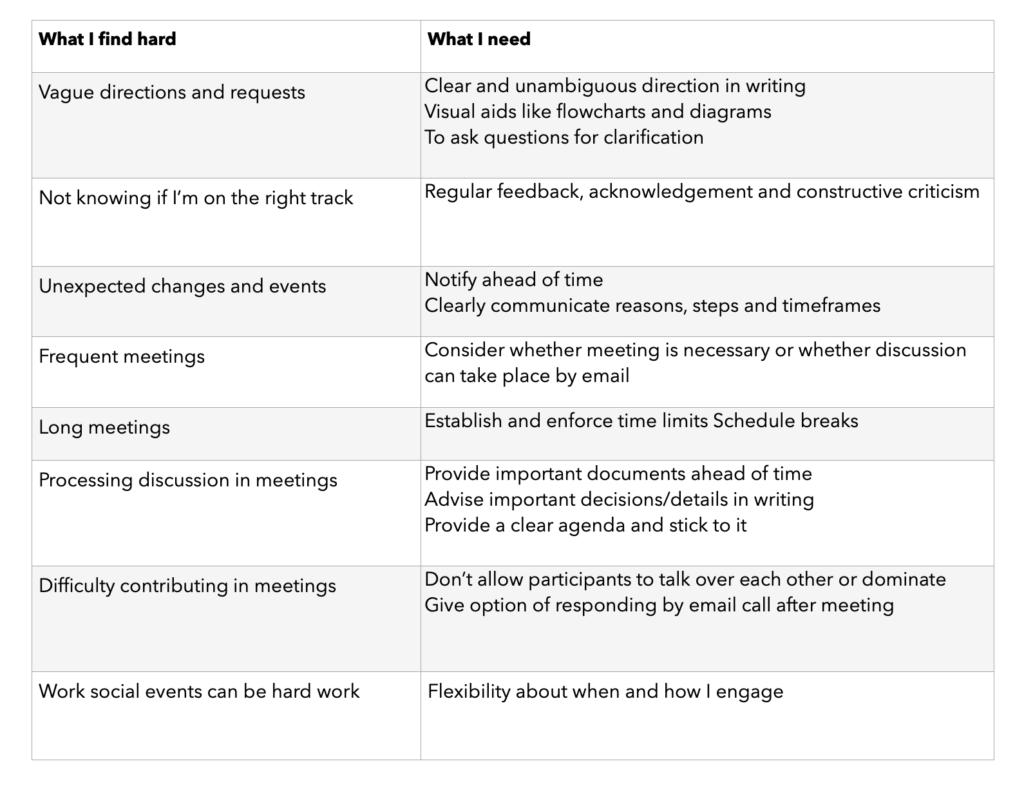
Written by Justine Field
While I’m lucky to be one of a minority of employed Autistic people, recalibrating my place within the workplace as a late-identified Autistic adult has had its own set of challenges.
Although I’ve had some measure of success as a lawyer, there’s been a lot of trial and error before finding my niche. My career trajectory is less of a linear road paved by measured steps in the direction of a goal and more of a disjointed trail left by ducking and weaving in the name of survival.
Until ten years ago, I was representing family law clients in a system that can be brutal. It was a chaotic and unpredictable environment where I was frequently belittled and humiliated by judges regardless of how prepared I was. Drowning in a culture of hyperachievement, I felt like I had fallen seriously short. My anxiety grew tentacles that reached into all corners of my life until, eventually, I released its grip by moving to a non-litigation role.
The immediate relief I felt was tinged with failure. Why had I found it so hard? Why couldn’t I get it together?
For many years I internalised the failure as entirely my own. It wasn’t until I was diagnosed Autistic that I realised just how much that environment had failed me. Thinking of myself as a disabled person in the workplace has been a big shift, but a liberating one. Now it’s less about what I can’t do and more about how I can best harness my strengths that include analysing, problem solving, writing and engaging deeply in subjects.
The conventional workplace adjustment process tends to be framed in terms of visible disabilities with a tangible response and a quantifiable cost. People understand that a person in a wheelchair needs free access to workplace spaces. When you have an invisible disability like Autism, you first have to convince your employer that you have different needs to your colleagues, a hurdle raised even further if – like me –you have worked hard to appear like everyone else.
Fear or uncertainty about the response of managers can be a barrier to Autistic people seeking workplace adjustments. While no employee should be obliged to disclose their condition, the reality is that it’s very difficult to have a meaningful discussion about your needs without disclosing the underlying reason for them. As proud as I am of my Autistic identity, the misconceptions that still exist around Autism mean there’s no way of knowing someone’s level of understanding and therefore how much mental energy will be involved in educating them or worse, defending myself.
The workplace encompasses an elaborate structure of practices, processes and attitudes that are shaped to fit the needs of neurotypical people. There’s no quick fix for workplace challenges arising from how people relate to each other – the conversational shorthand at the expense of detail; the dance around saying what they really mean; the preoccupation with inconsequential topics; the subterranean social dynamics. Riding the ebb and flow of neurotypical behavioural norms is relentlessly tiring.
A price we have paid for remote working is an escalation in the number of meetings through the use of video-conferencing platforms. There is scientific research on the increased cognitive load involved in these interactions and as an Autistic person who already has to work harder to process communication, Zoom fatigue takes on a whole new meaning.
It’s been a revelation to me that my mental energy is finite and that if I don’t account for it carefully, I end up overloaded and burnt out. The points at which my needs collide with workplace expectations require me to set boundaries and self-advocate. The table below is my attempt to articulate my workplace needs.

Some of these things would be common to a lot of Autistic people. Mostly, they are just good practice. While poor communication can impact on Autistic people disproportionately, good communication benefits everyone.
I’m fortunate to have been able to contribute to a new workplace adjustment policy being developed where I work. It includes a process that supports disabled employees and will sit alongside an inclusive practice policy for managers. Importantly, it strikes a balance between promoting awareness of barriers faced by particular groups including Autistic people and being open to what works for the individual employee rather than making assumptions.
The UK Law Society’s Reasonable Adjustments in Organisations: Guidance For Best Practice is a highly practical resource for workplaces. It suggests that managers take a pro-active approach by doing accessibility audits, reviewing policies, procedures and systems and providing disability training for all employees.
The concept of workplace adjustments needs to be normalised:
“Truly inclusive cultures appreciate that disabled or non-disabled – everyone works differently and may require adjustments at some time in their lives.”
Workplace adjustment processes need to be embedded within an inclusive and supportive culture that works for everyone. It should be standard practice for all employees to be invited to specify their work preferences so disabled employees aren’t seen to be seeking “special treatment”. There also needs to be a broader interrogation of ableist cultures such as the legal profession so they meet the needs of all those who come into contact with them. I hope that my small acts of self-advocacy can play a part in raising awareness and nudging workplace culture into a shape that is more inclusive for all.
If you would like to get in touch with Justine, please email her.

The Reframing Autism team would like to acknowledge the Traditional Owners of the lands on which we have the privilege to learn, work, and grow. Whilst we gather on many different parts of this Country, the RA team walk on the land of the Awabakal, Birpai, Whadjak, and Wiradjuri peoples.
We are committed to honouring the rich culture of the Aboriginal and Torres Strait Islander peoples of this Country, and the diversity and learning opportunities with which they provide us. We extend our gratitude and respect to all Aboriginal and Torres Strait Islander peoples, and to all Elders past and present, for their wisdom, their resilience, and for helping this Country to heal.